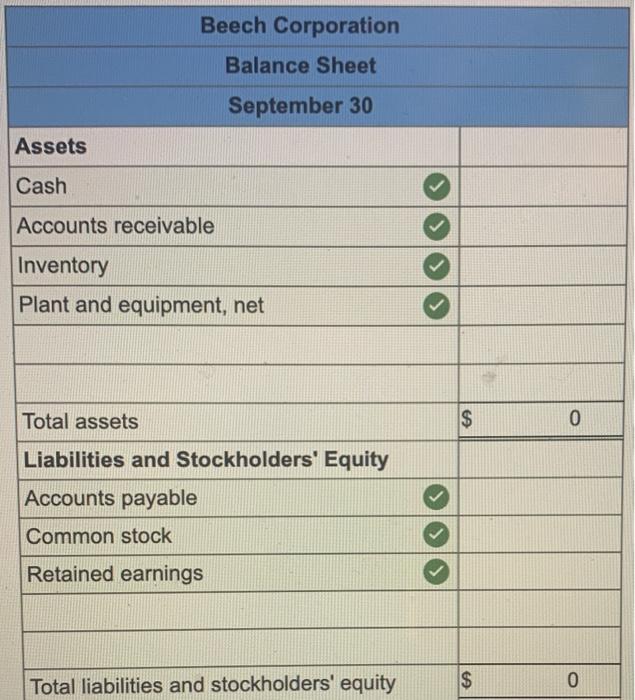Required information [The following information applies to the questions displayed below.) Beech Corporation is a merchandising company that is preparing a master budget for the third quarter of the calendar year. The company's balance sheet as of June 30th is shown below: Beech Corporation Balance Sheet June 30 Assets Cash Accounts receivable Inventory Plant and equipment, net of depreciation Total assets Liabilities and Stockholders' Equity Accounts payable Common stock Retained earnings Total liabilities and stockholders' equity $ 76,000 137,000 86,100 230,000 $ 529,100 $ 91,000 312,000 126, 100 $ 529,100 Beech's managers have made the following additional assumptions and estimates: 1. Estimated sales for July. August September, and October will be $410,000, $430,000. $420,000. 1. Estimated sales for July, August September, and October will be $410,000, $430,000, $420,000, and $440,000, respectively. 2. All sales are on credit and all credit sales are collected. Each month's credit sales are collected 35% in the month of sale and 65% in the month following the sale. All of the accounts receivable at June 30 will be collected in July 3. Each month's ending inventory must equal 30% of the cost of next month's sales. The cost of goods sold is 70% of sales. The company pays for 40% of its merchandise purchases in the month of the purchase and the remaining 60% in the month following the purchase. All of the accounts payable at June 30 will be paid in July 4. Monthly selling and administrative expenses are always $58,000. Each month $8,000 of this total amount is depreciation expense and the remaining $50,000 relates to expenses that are paid in the month they are incurred. 5. The company does plan to borrow money or pay or declare dividends during the quarter ended September 30. The company does not plan to issue any common stock or repurchase its own stock during the quarter ended September 30. Required: 1. Prepare a schedule of expected cash collections for July, August, and September 2-a. Prepare a merchandise purchases budget for July, August, and September. Also compute total merchandise purchases for the quarter ended September 30. 2-b. Prepare a schedule of expected cash disbursements for merchandise purchases for July, August, and September 3. Prepare an income statement that computes net operating income for the quarter ended September 30. 4. Prepare a balance sheet as of September 30. Quarter $ 137,000 Schedule of Expected Cash Collections Month July August September $ From accounts receivable 137,000 From July sales 143,500 266,500 From August sales 150,500 279,500 From September sales 147,000 Total cash collections $ 426,500 280,500 417,000 410,000 430,000 147,000 $ 1,124,000 Quarter September $ 294,000 132,000 Merchandise Purchases Budget July August Budgeted cost of goods sold $ 287,000 $ 301,000 Add: Desired ending merchandise inventory 90,300 88,200 Total needs 377,300 389,200 Less: Beginning merchandise inventory 86,100 90,300 Required purchases $ 291,200 $ 298,900 $ 882,000 88,200 86,100 Schedule of Cash Disbursements for Purchases July August September From accounts payable $ 91,000 From July purchases 116,480 174,720 From August purchases 119,560 179,340 From September purchases Quarter $ 91,000 291,200 298,900 0 Total cash disbursements $ 681,100 $ 179,340 207,480 294,280 Beech Corporation Income Statement For the Quarter Ended September 30 Sales 0 Cost of goods sold Gross margin Selling and administrative expenses Net operating income 1$ 0 Beech Corporation Balance Sheet September 30 Assets Cash Accounts receivable Inventory Plant and equipment, net Total assets $ 0 Liabilities and Stockholders' Equity Accounts payable Common stock Retained earnings Total liabilities and stockholders' equity $ 0













